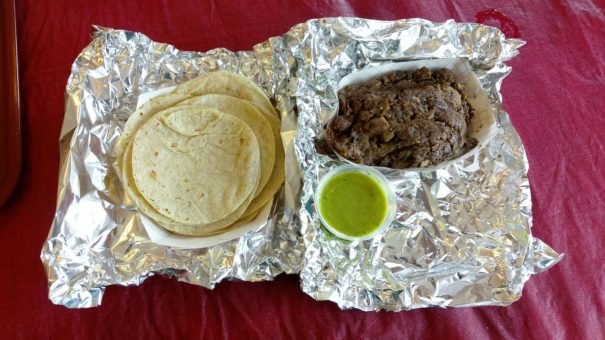
Too Late For Cheek Meat, But Just in Time for the Tongue Tacos

Too Late For Cheek Meat, But Just in Time for the Tongue Tacos
Barbacoa in South Texas
Vera’s Backyard Bar-B-Que is an understated temple to barbacoa in Brownsville, Texas. When two friends and I arrived at 10:45 one hot morning, Armando Vera, the owner, was turning customers away.
They were sold out.
Barbacoa has roots in the pre-colonial Americas and is prevalent throughout modern Mexico and the southwestern U.S., including the ranchlands of South Texas. Different animals are used in different regions, and many preparations now rely on contemporary kitchen technology. Vera’s is the only place in Texas that follows a traditional process, in which whole cattle heads are slowly cooked over live coals in a hole dug into the ground. They sell tortillas, salsa, and chopped onion and cilantro, alongside poundage of the different cuts of head meat. The eater assembles the taco.
I had been waiting for a visit for years, and couldn’t believe our tardy transgression. I lingered at the counter, and Mr. Vera ran a spoon around a steam table pan and came up with one last pound of lengua, or tongue. Cachete, or cheek, was gone, as was mixta, a combo of sundry edible bits, and ojo, or eye. Tortillas were sold out, too, but he made a call to get a pack delivered from the Capistran factory down the road.
On the plus side, overshooting our arrival meant that Vera and his crew had time to indulge our out-of-towner enthusiasm. We were full of questions and Vera anticipated what must be a common request from visiting foodies.
“You want to see the pit,” he said. Our eyes widened.
But we were getting ahead of ourselves. First, we made tacos with the fatty, faintly smoky lengua and the local corn tortillas. A tangy green salsa balanced the rich, but not gamey, meat. We were temporarily silenced. It was the best Texas-style barbacoa I’ve had.
After eating, Vera’s college-bound daughter and two employees walked us to the detached cinderblock building where the heads are prepared and cooked. The pit room is roofless and contains the rectangular pozo where mesquite coals are used. Only cooled ash remained in its depths at that time of day.
Years ago, Vera lined the rough pit with firebrick and, at the restaurant’s volume peak in 1993, was cooking 80 heads at a time. While they don’t sell quite so many now, Vera’s business seems to be picking up. The restaurant landed on the Texas Monthly magazine’s influential list of the state’s Top 50 Barbecue Joints for 2017. The weekend-only schedule recently expanded to include Fridays. The menu has grown to include meats like brisket and carnitas.
We shared the dining room with a longtime customer named Cervantes, friendly and dapper in a straw fedora. He’s been eating at Vera’s since Armando Vera was a child; Vera’s parents opened the restaurant in 1955. Cervantes started limiting his visits for health reasons before realizing (or rationalizing) that cachete isn’t as fatty as the other cuts. He’s back to eating there most weekends.